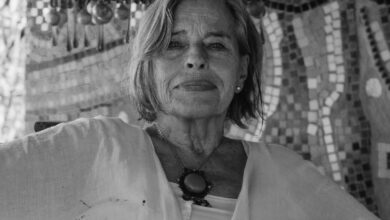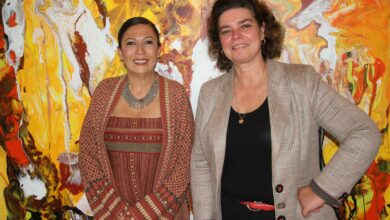“I reject style–only emotions matter,” says prominent Egyptian painter Adel El Siwi. Nominated by Culture Minister Farouk Hosni to represent Egypt at the last Biennale in Venice, El Siwi is currently showcasing his latest works at the Horizon One gallery in Cairo’s Dokki district until 17 February. Al-Masry Al-Youm visited the artist in his downtown workshop to talk about his art, with a special focus on his current exhibition.
Al-Masry Al-Youm: This exhibition is the result of a number of influences: Pharaonic, African and surrealism, among others. What is the common thread that links these pieces together?Adel El
Siwi: With this exhibition, I thought about escaping the trap of style that limits the artist who can only present one theme, one subject. My idea was to recount the memories, the stories and fables I was told throughout my existence, and transform them into a ribbon of emotions that runs from one painting to the next. It may be confusing at first, because the link is not visual–it’s solely based on the feelings they exude. I reject style in the sense that it reduces artistic horizons. In my latest work, only emotions matter. You can find this kind of emotional composition in movies as well, when the director shoots a bustling street, then a lamppost, a window and a flower pot. All these objects are visually disconnected–but when linked together by the movement of the camera, they tell a story and spur an emotion. If I walk in the streets of Cairo and see a man wearing a galabeya and right after a woman wearing a Niqab, they may be different, but they also share some common things behind these different shapes.
Al-Masry: How do you explain the dreamy mood that overcomes the visitor when he or she experiences the works in your latest exhibition?
El Siwi: I work with different layers and various levels of understanding. On the painting entitled “The tale of the monkey and the deer” for example, what attracts the eye first are the two very accentuated figures of these animals. Next, you start discerning the outlines of the animals behind, which may be the most important characters of the painting. Another example is “The lady with the man,” the painting that appears on the poster of the exhibition. First you see the woman, who is dressed in red and seems very powerful. Next, the shape of the man in sketches in front of her gradually appears like an ephemeral apparition.
Al-Masry: You seem fascinated by animals and their relationship to man. How do you explain this artistic inclination?
El Siwi: I realized that the attitudes I gave to many of the figures that I paint are directly inspired by animals. The way the animals move their bodies, freeze and pace as if they were perpetually tense is a great source of inspiration. Animals are very important in our lives because they spur positive emotions that help a home remain stable. I also despise the prevailing anthropo-centrism that sees human beings as the center of the universe. My intense relationship with animals may be linked to my childhood in the Delta, where relations with animals are completely different than they are in the city. My childhood universe was filled with stories in which animals tell stories to people or are reincarnations of powerful men.
Al-Masry: What aspects of Pharaonic painting inspire you the most?
El Siwi: I like the idea that they were not creating logic space or three-dimensional space, because it gives their art a very contemporary feel. They create an artistic work which has no respect for space whatsoever, and put things close to one another–not according to what they look like, but according to what they feel. The idea of flattening depths and volumes is brilliant. I also like the fact that you don’t feel the weight of the characters–they are shadowless, rigid characters. The elegance, nobility and solemnity they exude are also aspects that inspire me a lot.
Al-Masry: How has your art evolved in the last couple of years?
El Siwi: I wouldn’t say it has evolved per se, but I have definitely started to explore new fields with my painting. For a long time, I was fascinated by the human face and figure. Most of my work was focused on these parts of the body. In this exhibition, I have the feeling that I’m opening new realms of curiosity about sarcasm and irony. The irony is coming from the detachment of the artist. For example, in the series of diptychs on Egyptian mothers and daughters, I never wanted to show their suffering because I know that all too well. I mostly focused on the power and energy they have to laugh their miseries away by grabbing a tabla, or drum, and singing together. I wanted to depict the solid aspects of life–the unafraid and the daring.




